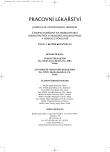Risk of Cardiovascular Diseases in Selected Professions
Authors:
J. Chaloupka; K. Wolfová
Authors‘ workplace:
Klinika nemocí z povolání LF UK a FN Hradec Králové
přednosta Doc. MUDr. Jiří Chaloupka, CSc.
Published in:
Pracov. Lék., 60, 2008, No. 2, s. 51-60.
Category:
Original Papers
Overview
The occupational medical care is an important part of the preventive care of the population in a productive age. We have undertaken diagnostics of selected risk factors of the most common diseases of mass occurrence in the framework of the occupational medical care. 5018 military professionals, 860 firemen-rescuers and 509 employees of other professions working in administration, industries, services, building industry and drivers were examined. The values of body mass index, blood pressure, glycaemia, urea, creatinine, liver tests, urinary acid and basic parameters of a lipoprotein spectrum were measured. The correlation analysis of selected parameters related to age was undertaken. The highest BMI values were found in drivers. The highest average values of blood pressure were measured in firemen. The high cholesterolaemia was found in building workers, drivers and employees in services. The highest accumulation of risk factors was observed in drivers, firemen and building workers, the lowest one in administrative workers and soldiers. The number and degree of risk factors increase with age, however this trend has different accents in different professional groups.
Key words:
atherosclerosis, ischemic heart disease, preventive examinations, occupational medical care, risk factors, cholesterol, blood pressure, soldiers, firemen, employees
Sources
1. ASSMANN, G., CULLEN, P., SCHULTE, H. The Műnster heart study (PROCAM). Eur. Heart J., 1998, 19, s. A2–A11.
2. Cífková, R., Býma, S., Češka, R., Horký, K., Karen, I., Kunešová, M., Králíková, E., Rosolová, H., Roztočil, K., Soška, V., Škrha J. Prevence kardiovaskulárních onemocnění v dospělém věku. Společné doporučení českých odborných společností. Cor. Vasa, 2005, 47, 9 Suppl., s. 3–14.
3. CLEEMAN, J. I., LENFANT, C. The National cholesterol education program. Progress and prospects. JAMA, 1998, 280, s. 2099–2104.
4. Conroy, R. M., Pyöräla, K., Fitzgerald, A. P. et al. Estimation of ten-year risk of fatal cardiovascular disease in Europe: the SCORE Project. Eur. Heart J., 2003, 11, s. 987–1003.
5. Coutinho, H. P. jr., Putman, S. F., Kassell, N. F., Torner, J. C. The relationship between glucose and incident cardiovascular events. A metaregression analysis of published data from 20 studies of 95 783 individuals followed for 12,4 years. Diabetes Care, 1999, 22, s. 233–240.
6. CRIQUI, M. H. Triglycerides and cardiovascular disease. Eur. Heart J., 1998, 19, Suppl. A, s. A36–A39.
7. Cuspidi, C., Valerio, C., Sala, C., Esposito, A., Masaidi, M., Negri, F., Zanchetti, A., Mancia, G. Prevalence and correlates of multiple organ damage in a never-treated hypertensive population: role of ambulatory blood pressure. Blood Press Monit., 2008, 13, 1, s. 7–13.
8. De Backer, G., Ambrosioni, E., Borch-Johnsen, K., Brotons, C., Cífková, R., Dallongeville, J. et al. European guidelines on cardiovascular disease prevention in clinical practice. Eur. Heart J., 2003, 24, s. 1601–1610.
9. Farmer, J. A. Diabetic dyslipidemia and atherosclerosis: evidence from clinical trials. Curr. Atheroscler. Rep., 2007, 9, 2, s. 162–168.
10. GARDNER, CH. D., FORTMANN, S. P., KRAUSS, R. M. Association of small low-density lipoprotein particles with the incidence of coronary artery disease in men and women. JAMA, 1996, 276, s. 875–881.
11. Grundy, S. M., Cleeman, J. I., Merz, N. B. et al. Implications of recent clinical trials for the National Cholesterol Education Program, Adult Treatment Panel III Guidelines. Circulation, 2004, 110, s. 227–239.
12. http://www.who.int/infobase/comparestart.aspx
13. Lees R, S. Prevention of atherosclerosis progression in asymptomatic healthy elderly. Am. J. Clin. Nutr., 2007, 86, 5, s. 1569S–1571S.
14. Mathieu, P., Pibarot, P., Larose, E., Poirier, P., Marette, A., Després, J. P. Visceral obesity and the heart. Int. J. Biochem. Cell Biol., 2008, 40, 5, s. 821–836.
15. Naya, T., Hosomi, N., Ohyama, H., Ichihara, S., Ban, C. R., Takahashi, T., Taminato, T., Feng, A., Kohno, M., Koziol, J. A. Smoking, fasting serum insulin, and obesity are the predictors of carotid atherosclerosis in relatively young subjects. Angiology, 2007–2008, 58, 6, s. 677–684.
16. Poledne, R., Rosolová, H. Reverse cholesterol transport influences substantially the individual risk of coronary heart disease in hypercholesterolemic patients. Eur. Heart J., 2001, 22, s. 442–443.
17. Segura, J., Ruilope, L. M. Obesity, essential hypertension and renin-angiotensin system. Public Health Nutr., 2007, 10, 10A, s. 1151–1155.
18. Third Report of the National Cholesterol Education Program (NCEP) Expert Panel on Detection, Evaluation, and Treatment of High Blood Cholesterol in Adults (Adult Treatment Panel III). NIH Publication 02-5215. Circulation, 2002, 106, s. 3143–3420.
19. Wassink, A. M., van der Graaf, Y., Olijhoek, J. K., Visseren, F. L. for the SMART Study Group. Metabolic syndrome and the risk of new vascular events and all-cause mortality in patients with coronary artery disease, cerebrovascular disease, peripheral arterial disease or abdominal aortic aneurysm. Eur. Heart J., 2008, 29, 2, s. 213–223.
20. Zdravotnická ročenka České republiky 2005, ÚZIS Praha, 2006.
Labels
Hygiene and epidemiology Hyperbaric medicine Occupational medicineArticle was published in
Occupational Medicine

2008 Issue 2
Most read in this issue
- Professional Allergies to Disinfectants
- Allergic Bronchopulmonal Aspergillosis as an Occupational Disease
- Risk of Cardiovascular Diseases in Selected Professions
- Professional Health Impairments in Women Reported in the Czech Republic between 2001 and 2006
